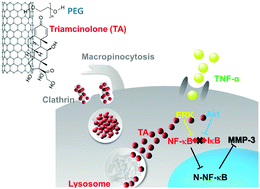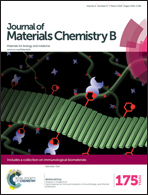Triamcinolone–carbon nanotube conjugation inhibits inflammation of human arthritis synovial fibroblasts†
Abstract
Repetitive intra-articular corticosteroid injections are inevitable for treating synovial inflammation in advanced arthritis. However, short- and long-term use of corticosteroids usually triggers serious side effects (i.e., adrenal insufficiency, hyperglycemia, Cushing syndrome, osteoporosis, Charcot arthropathy, etc.). This study demonstrated that conjugation of a corticosteroid (triamcinolone) on polyethylene-glycol (PEG)-fabricated multi-walled carbon nanotubes enhances intracellular drug delivery via increased lysosome transport and ultimately suppresses the expression of major pro-inflammatory cytokines (i.e., TNF-α, IL-1β, and IL-6) and matrix metalloproteinase-1 and -3 from fibroblast-like synoviocytes at a very low drug dose. Specifically, conjugation of triamcinolone and multi-walled carbon nanotubes inactivated nuclear factor-κB via inhibition of the phosphorylation of mitogen-activated protein kinases and the serine/threonine kinase Akt. In summary, low-dose triamcinolone conjugation with carbon nanotubes significantly inhibited the inflammatory response of fibroblast-like synoviocytes by achieving highly efficient intracellular trafficking and suggested a potential drug candidate for resolving side effects associated with conventional arthritis treatment.

- This article is part of the themed collection: Immunological Biomaterials

 Please wait while we load your content...
Please wait while we load your content...